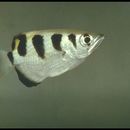Diagnostic Description
provided by Fishbase
Description: Body silver or white, dorsal vertical stripes broad black four, or patches; head band black or grey at preopercle level. Body depth 2.1-2.4 in SL. Dorsal 3rd spine 1.7-1.9 in HL, longest. Scale horizontal rows 3-4 above LL, 8-9 below LL.
Diseases and Parasites
provided by Fishbase
Skin Fungi (Saprolegnia sp.). Fungal diseases
Diseases and Parasites
provided by Fishbase
Bacterial Infections (general). Bacterial diseases
Migration
provided by Fishbase
Amphidromous. Refers to fishes that regularly migrate between freshwater and the sea (in both directions), but not for the purpose of breeding, as in anadromous and catadromous species. Sub-division of diadromous. Migrations should be cyclical and predictable and cover more than 100 km.Characteristic elements in amphidromy are: reproduction in fresh water, passage to sea by newly hatched larvae, a period of feeding and growing at sea usually a few months long, return to fresh water of well-grown juveniles, a further period of feeding and growing in fresh water, followed by reproduction there (Ref. 82692).
Morphology
provided by Fishbase
Dorsal spines (total): 4; Dorsal soft rays (total): 11 - 13; Analspines: 3; Analsoft rays: 15 - 17
Trophic Strategy
provided by Fishbase
Feeds at the surface during daytime on floating debris which includes insects and vegetable matter. It is renowned for its ability to 'shoot down' insect prey by expelling beads of water from its mouth with considerable force and for its remarkable ability to compensate for visual refraction when aiming its shoots; shooting range is about 150 cm.
- Recorder
- Drina Sta. Iglesia
Biology
provided by Fishbase
Occurs primarily in brackish mangrove estuaries, but also penetrates rivers and small streams (Ref. 4833, 44894). Reported to occur near overhanging vegetation on reefs (Ref. 9710, 48636). Usually in small aggregations (Ref. 48635). Feeds at the surface during daytime on floating debris which includes insects and vegetable matter. It is renowned for its ability to 'shoot down' insect prey by expelling beads of water from its mouth with considerable force and for its remarkable ability to compensate for visual refraction when aiming its shoots; shooting range is about 150 cm (Ref. 2847, 55339). Sold fresh in markets.
Importance
provided by Fishbase
fisheries: minor commercial; aquarium: commercial

